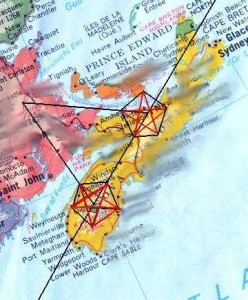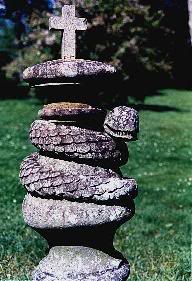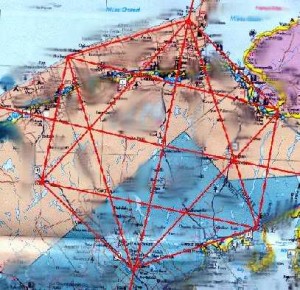
Over the past ten years or more, John Coleman has been researching a phenomenon in Nova Scotia. Could his discoveries which have been shielded over time from the general public shed any light on the mystery of Oak Island?
He has discovered a large number of geometric figures which are marked by monuments ranging from pre-Colombian origin to relatively modern constructions. The juxtaposition of these monuments from contrasting historical periods suggests that any reasoning behind such geometry is not just concerned with bygone days.
When these very large geometric figures are marked out on a map of Nova Scotia, Canada an interesting formation clearly becomes visible.
The place names that feature at the designated points are significant as they all include the word ‘cross’, either in their current or historical names. The names are likely to be in French, English or Mi’kmaq, depending on the period in which they were named.
This was also seen in the theory professing the association with the Knights Templar and Rennes le Chateau where place names persistently reflected their involvement in the area, especially considering the links with the cross symbol which represents the Templar. Could this be further evidence to support their mysterious involvement in Nova Scotia?
The precise mathematics involved in defining the figure, Coleman claims would impress a modern day surveyor. Coleman was able to ascertain the points of intersection through the use of a hand held GPS system and then calculate the central point of each figure.
John Coleman soon discovered that at the centre of hexagrams were to be found at a variety of interesting locations. At the centre of one hexagram, he discovered a museum called Mt. Uniacke House which had been given to the people of Canada by its now deceased curator.

What is interesting that on the property of the museum, at the very location where the centre of the hexagon would be, stood a bizarre monument. Workers at the museum do not know the significance of this marker which, it would seem, has been lost with the original owner.
The hexagrams are all of the same size and the central monument occupies the centre of the formation, joining or linking all other monuments relating to several Nova Scotian mysteries.
To support his studies further, John Coleman has also discovered a series of walls deep in Nova Scotia which he believes to be far from any present day civilisation. When attempting to find the centre of these strange geometric formations, he found a length of stone wall which is part of a larger structure of interlinking walls.
Discussions with anthropologists led to the conclusions that these walls were in fact man-made and not of natural formation. The rocks have clearly been engineered and placed close together yet they are very large, measuring up to 1.5 square metres. Another area within the proximity to these walls could possibly an area from which these rocks were cut but the question remains, for what means?
Many of the points Coleman demonstrates of interest are located on the site of a Freemason Hall, an Anglican Church, areas which have been damned to reclaim marshes and other areas which have been damned for no apparent reason. Interestingly, some monuments are situated near a copse of Oak trees and often correspond to mineral deposits.

The existence of these monuments clearly must serve as concrete evidence when considering the mathematical precision with which the hexagrams have been constructed with such hi-tech equipment as GPS navigation systems. It is certainly worth considering a link between Oak Island and these other fascinating formations on the mainland of Nova Scotia. Both Oak Island and John Coleman’s discoveries appear to hold a correlation on the importance of geometry. Perhaps the activities occurring on Oak Island were part of a larger, stranger operative which has yet to be discovered.
John Coleman is available to answer your questions and would love to hear any suggestions you may have regarding his discoveries. Visit his website, Mysteries in Nova Scotia.